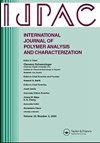WTR-PP复合材料的混炼策略及拉伸强度表征
IF 1.7
4区 工程技术
Q4 POLYMER SCIENCE
International Journal of Polymer Analysis and Characterization
Pub Date : 2023-01-01
DOI:10.1080/1023666X.2023.2238439
引用次数: 0
摘要
随着全球车辆数量的不断增加,轮胎报废后的处理也随之增加。一种潜在的回收方法是将废轮胎与热塑性材料结合,将其转化为有用的复合材料。本研究以废轮胎橡胶(WTR)和聚丙烯(PP)为原料,利用单螺杆长丝挤出机,在不同的WTR浓度(20、40、60和80%重量)下,制备了复合材料。对WTR(425µm)和WTR- pp复合材料进行了物理和形态表征;此外,还对WTR-PP复合材料在拉伸载荷下的力学性能进行了表征。形态学观察表明,与WTR含量较高的复合材料相比,WTR含量较低的WTR- pp分布较好,保持了复合材料应有的强度和热塑性。拉伸研究表明,聚丙烯与WTR的掺入降低了拉伸强度,但提高了断裂伸长率。采用宏观断口分析方法研究了WTR-PP复合材料的失效起源和裂纹扩展。本文章由计算机程序翻译,如有差异,请以英文原文为准。
Mixing strategy and tensile strength characterization of WTR-PP composite
As vehicles are on the rise globally, so is tire disposal when out of service. One potential recycling process is turning the waste tire into a useful composite by incorporating it with thermoplastic materials. In the present work, composite based on waste tire rubber (WTR) and polypropylene (PP) were developed using a single screw filament extruder for various concentrations of WTR (20, 40, 60, and 80% wt.). Physical and morphological characterization of WTR (425 µm) and WTR-PP composite was performed; furthermore, mechanical characterization of WTR-PP composites was also carried out under the tensile load. Morphological observation reveals that WTR-PP with low WTR content shows comparatively better distribution, maintaining the necessary strength and thermoplasticity of the composite compared to the higher WTR content in the composite. The tensile study shows that incorporating WTR with polypropylene decreased tensile strength but improved elongation at break. The macrofractography is carried out to study the failure origin and crack propagation in the WTR-PP composite.
求助全文
通过发布文献求助,成功后即可免费获取论文全文。
去求助
来源期刊
CiteScore
3.50
自引率
5.30%
发文量
37
审稿时长
1.6 months
期刊介绍:
The scope of the journal is to publish original contributions and reviews on studies, methodologies, instrumentation, and applications involving the analysis and characterization of polymers and polymeric-based materials, including synthetic polymers, blends, composites, fibers, coatings, supramolecular structures, polysaccharides, and biopolymers. The Journal will accept papers and review articles on the following topics and research areas involving fundamental and applied studies of polymer analysis and characterization:
Characterization and analysis of new and existing polymers and polymeric-based materials.
Design and evaluation of analytical instrumentation and physical testing equipment.
Determination of molecular weight, size, conformation, branching, cross-linking, chemical structure, and sequence distribution.
Using separation, spectroscopic, and scattering techniques.
Surface characterization of polymeric materials.
Measurement of solution and bulk properties and behavior of polymers.
Studies involving structure-property-processing relationships, and polymer aging.
Analysis of oligomeric materials.
Analysis of polymer additives and decomposition products.

 求助内容:
求助内容: 应助结果提醒方式:
应助结果提醒方式:


